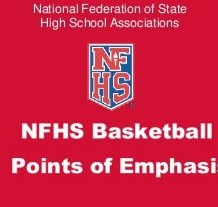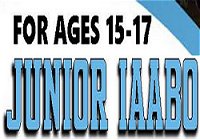NFHS 2023-24 Points of Emphasis

2023-24 Points of Emphasis
Uniforms, Equipment and Apparel
The NFHS regularly receives questions regarding the legality of uniforms, equipment and apparel. It is imperative that not only officials understand the rules governing uniforms and equipment, but coaches and players as well. Uniform jerseys must comply with the rules listed in 3-4, 3-5 and 3-6. The rules are concise and clear regarding what is and is not permissible on the jersey. An NFHS basketball uniform guide was created to illustrate the proper uniform design graphically. That document and an animated presentation can be found on the NFHS website.
Uniforms
A. Requests to make an exception to Rule 3-4, Uniforms (e.g., Pink Out night, Retro/Throw Back night, Military Appreciation night) must be submitted to the state association before the event for approval. Uniform requirements MAY NOT be altered by mutual agreement between schools or coaches.
B. As has been the rule in the past, uniform bottoms do not have to match the torso of the uniform; however, with the adoption of Rule 3-4-5, uniform bottoms must be like-colored among teammates. To provide clarity, the following examples are provided:
• Teammates may wear multiple styles of uniform bottoms, which may include shorts, skirts or pants.
• The color of the uniform bottoms are not required to be the same as the uniform
top; however, the bottoms must be a consistent color among teammates. The bottom style may differ for every player, but the color must be the same.
Example – A1 is wearing a white jersey and red shorts. A2 is wearing a white jersey and a red skirt. Legal, as long as the bottom is red for all five players.
C. Rolling and/or tucking of uniform bottoms is permissible, as long as the compression tights/sleeves, if worn, are color compliant.
Equipment and Apparel
A. Undershirts, if worn, must adhere to the following:
• Home Team – Shall be white, shall be hemmed, and shall not have frayed or ragged edges. If the undershirt has sleeves, they shall be the same length.
• Visiting Team – Shall be a single solid color similar to the torso of the jersey OR be solid black. The undershirt shall be hemmed and shall not have frayed or ragged edges. If the undershirt has sleeves, they shall be the same length. Team members may wear either a single solid color similar to the torso of the jersey or black, but not both.
Example – Visitor B1 wears a purple jersey and a black undershirt. Visitor B2 is wearing a purple jersey and purple undershirt. Illegal. Both undershirts are a legal color; however, teammates must wear the same color undershirt. This situation would be legal if all teammates wore a black undershirt or if all teammates wore a purple undershirt.
B. Arm sleeves, knee sleeves, lower leg sleeves, compression shorts and tights are permissible:
• Anything worn on the arm and/or leg is a sleeve, except a knee brace, and shall meet the color restrictions.
• The sleeves/tights and compression shorts shall be black, white, beige or the predominant color of the jersey, and the same color sleeves/tights shall be worn by teammates.
• All sleeves/tights and compression shorts shall be the same solid color and shall be the same solid color as any headband or wristband worn. Coaches and school administrators must ensure that legal uniforms are being ordered and purchased from manufacturers/distributors.
If in doubt, PRIOR to purchasing uniforms, equipment or apparel, confirm legality with the local state association.
Bench Decorum
The rules committee is concerned about bench decorum rule violations by coaches and bench personnel. Only through enforcing existing rules will coaches and bench personnel exhibit appropriate and acceptable behaviors. Coaches are expected to remain in the coaching box. The extension of the coaching box six years ago was intended to allow coaches to communicate with their players near the end line without violating the Coaching Box rule or creating a need to come onto the playing court.
Coaches who go beyond the 28-foot line, or more importantly, onto the playing court, gain a distinct advantage, which is not within the spirit and intent of the rules. Coaches are reminded that while the bench area expands during a time-out, the bench area does not extend beyond the 28-foot line. Coaches and other bench personnel may not move to the expanded bench area until the time-out begins to ensure bench personnel do not create inadvertent contact with opposing players still out on the playing court. Coaches who leave the expanded bench area to engage officials inappropriately are subject to a warning or a bench technical foul. Misconduct by players, coaches and bench personnel is not permitted. There is continued support for officials to use all the tools at their disposal. These tools include promptly issuing an administrative warning for misconduct by coaches and bench personnel or assessing a technical foul if warranted. Players’ taunting, baiting, finger-pointing, trash-talking, and using inappropriate gestures have increased during the past several seasons. Specifically, trendy hand gestures and body language meant to demean, and single-out opponents is not a reflection of good sporting behavior and has no place in the interscholastic setting. Players and coaches are permitted to celebrate an individual or team accomplishment, but they cannot direct that celebration toward their opponent. Also, players and coaches are not allowed to disrespectfully or inappropriately address and/or gesture at an official after a ruling is made on the court. Player and coach behavior, which in the official’s judgment is determined to be a taunt of an opponent or a disrespectful act toward an official, shall be penalized by assessing a technical foul. Assistant coaches are not authorized to approach the scorer’s table at any time. The head coach is permitted to go to the scorer’s table to request a 60-second time-out to confer with personnel regarding a correctable error or to prevent or rectify a timing or scoring mistake/error or an alternating possession mistake.
Throw-Ins – Proper Locations
Proper inbound spots contribute to the overall flow and fairness of the game. When the ball is inbounded from the correct location, it ensures that the offense and defense have an equal chance to contest the possession. It prevents teams from gaining an unfair advantage by manipulating the inbound spot, which could disrupt the balance of the game. Coaches design specific plays and offensive/defensive strategies based on where the ball will be put in play. It is, therefore, essential for game officials to be diligent in administering the ball at the proper throw-in location. With the adoption of Rules 7-5-2 through 7-5-4 coaches, players and officials are reminded of the following rules governing throw-in locations:
A. Anytime a team causes the ball to go out of bounds in either the frontcourt or the backcourt, the throw-in occurs from the spot where the ball went out of bounds.
B. When a violation by either team, a foul before the bonus by either team or dead ball (i.e., an inadvertent whistle or a held ball) occurs that will result in a throw-in, officials must ask themselves three questions: Where did the violation/foul occur? Is the throw-in team in its frontcourt or backcourt? Where was the ball when the interruption occurred?
1. If the throw-in is to be in the team’s frontcourt, it shall be at either the nearest 28-foot mark along each sideline or the nearest spot 3 feet outside the lane line and the end line. (Diagram 5)
2. If the throw-in is to be in the team’s backcourt, the throw-in shall be at the designated spot nearest to where the foul, violation or other stoppage in play occurred.
End-of-Game Protocols
As a game nears the end of playing time, officials need to remind each other of the game-ending procedures to prevent potential issues. Oftentimes, late game time-outs will provide the best opportunities to:
A. Confirm the following with the scorer:
1. Accuracy of the official scorebook
2. The number of time-outs remaining for each team (inform the head coach if the team has used its last time-out)
3. The number of team fouls and impact on the bonus.
B. Remind the timer of the following:
1. Watch the officials for the clock-start and clock-stop signals
2. Be prepared to assist in aiding the officials regarding whether a last-second shot was released prior to the end of time, especially if the gym is loud and the officials cannot hear the final horn.
C. Officials should discuss the following:
1. Last-second shot responsibility (trail official 2-person, center/trail 3-person)
2.Unless the ball is tapped, no try can be attempted on a throw-in or free throw with three-tenths (.3) of a second or less remaining
3. Intentional/flagrant fouls are two shots and a designated spot throw-in, as discussed during the pre-game conference
4. If a foul occurs as the game-ending horn sounds and the score can be tied or the game won by the ensuing free throws, the official must administer the free throws. If the free throws will not change the outcome, the free throws will not be attempted.
D. If the score is tied at the end of regulation time, inform each team and the table officials of the overtime procedures (length of overtime period, additional 60-secondtime-out, etc.).
E. Following the game-ending horn, the referee should confirm with the scorer that everything is correct, then leave the floor with their partner(s). In situations when the score is separated by three points or less, it may be necessary to verbally confirm with the scorer. In games where the margin of victory is larger, a visual signal such as a thumbs-up will suffice. Be confident that everything is correct, as the officials’ jurisdiction ends when they leave the visual confines of the playing court.






